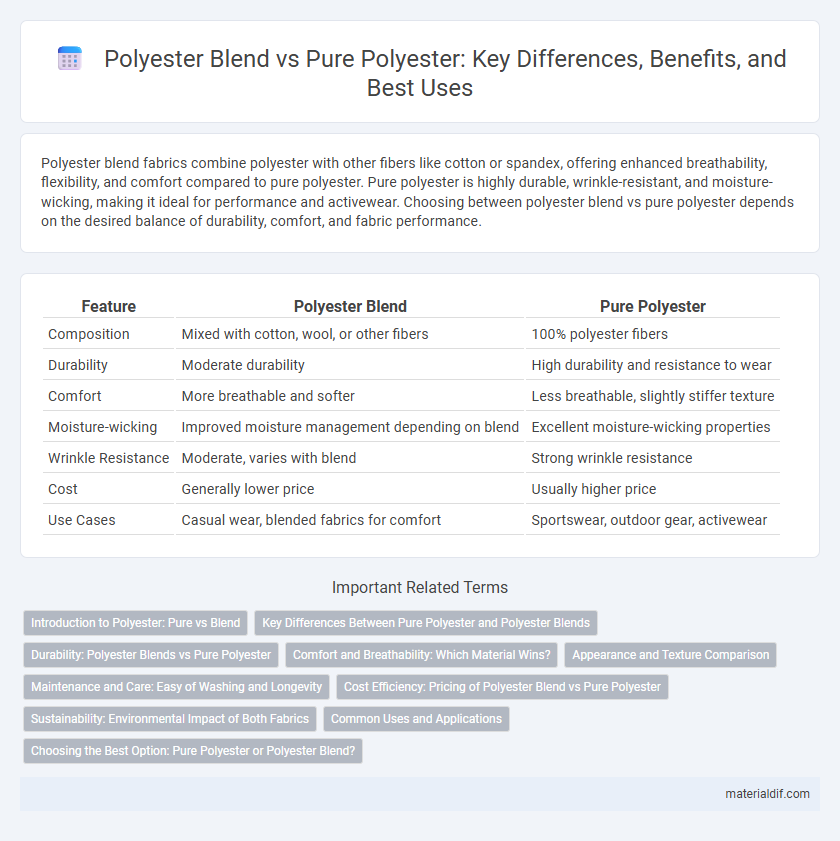Polyester blend fabrics combine polyester with other fibers like cotton or spandex, offering enhanced breathability, flexibility, and comfort compared to pure polyester. Pure polyester is highly durable, wrinkle-resistant, and moisture-wicking, making it ideal for performance and activewear. Choosing between polyester blend vs pure polyester depends on the desired balance of durability, comfort, and fabric performance.
Table of Comparison
| Feature | Polyester Blend | Pure Polyester |
|---|---|---|
| Composition | Mixed with cotton, wool, or other fibers | 100% polyester fibers |
| Durability | Moderate durability | High durability and resistance to wear |
| Comfort | More breathable and softer | Less breathable, slightly stiffer texture |
| Moisture-wicking | Improved moisture management depending on blend | Excellent moisture-wicking properties |
| Wrinkle Resistance | Moderate, varies with blend | Strong wrinkle resistance |
| Cost | Generally lower price | Usually higher price |
| Use Cases | Casual wear, blended fabrics for comfort | Sportswear, outdoor gear, activewear |
Introduction to Polyester: Pure vs Blend
Polyester, a synthetic fiber derived from petroleum-based polymers, is widely used in textiles for its durability and resistance to wrinkles and shrinking. Pure polyester consists entirely of polyester fibers, offering strong moisture-wicking properties and excellent color retention, making it ideal for activewear and performance fabrics. Polyester blends combine polyester with natural fibers like cotton or wool, enhancing breathability and comfort while maintaining polyester's strength and wrinkle resistance.
Key Differences Between Pure Polyester and Polyester Blends
Pure polyester is made entirely from synthetic polymer fibers, offering high durability, wrinkle resistance, and moisture-wicking properties. Polyester blends combine polyester with natural fibers like cotton or wool, enhancing breathability, comfort, and softness while maintaining some of polyester's strength and wrinkle resistance. These blends often provide better temperature regulation and reduced static cling compared to pure polyester.
Durability: Polyester Blends vs Pure Polyester
Polyester blends combine polyester fibers with natural or synthetic materials, enhancing durability by reducing susceptibility to pilling and increasing resistance to wear compared to pure polyester. Pure polyester, while inherently strong and abrasion-resistant, may be less flexible and prone to static buildup, which can affect long-term fabric integrity. Blended fabrics typically offer superior strength and longevity, making them ideal for high-use applications where durability is a critical factor.
Comfort and Breathability: Which Material Wins?
Polyester blends often enhance comfort and breathability compared to pure polyester by incorporating natural fibers like cotton or rayon, which improve moisture absorption and airflow. Pure polyester tends to trap heat and moisture due to its synthetic nature, making it less breathable and sometimes causing discomfort during extended wear. Choosing a polyester blend can provide a better balance of durability and comfort, especially for active or warm-weather use.
Appearance and Texture Comparison
Polyester blends often exhibit a softer texture and more natural drape compared to pure polyester, which tends to have a slightly stiffer feel and shinier appearance. The integration of fibers such as cotton or rayon in polyester blends enhances breathability and reduces the synthetic sheen found in 100% polyester fabrics. Pure polyester maintains durability and wrinkle resistance, but its uniform finish may lack the varied texture and matte quality observed in blended textiles.
Maintenance and Care: Easy of Washing and Longevity
Polyester blends often offer enhanced durability and easier maintenance compared to pure polyester, as the addition of fibers like cotton or spandex improves breathability and reduces wrinkles. Pure polyester resists shrinking and stretching but may require lower washing temperatures to maintain its integrity and prevent damage. Both fabrics benefit from machine washing on gentle cycles and air drying to extend longevity, though blends often dry faster and maintain shape better over time.
Cost Efficiency: Pricing of Polyester Blend vs Pure Polyester
Polyester blends generally offer greater cost efficiency compared to pure polyester due to lower material expenses and enhanced durability, reducing overall garment maintenance and replacement costs. Pure polyester tends to have higher raw material and manufacturing costs but provides superior moisture-wicking and wrinkle resistance, potentially justifying the price for performance-focused applications. The choice between polyester blend and pure polyester ultimately depends on budget constraints and the desired balance between cost savings and fabric performance.
Sustainability: Environmental Impact of Both Fabrics
Polyester blends often contain natural fibers, reducing overall reliance on synthetic polymers and enhancing biodegradability compared to pure polyester. Pure polyester, derived from petroleum, has a higher carbon footprint and contributes more to microplastic pollution during washing. Choosing polyester blends can mitigate environmental impact by combining durability with improved sustainability profiles through reduced resource consumption and waste generation.
Common Uses and Applications
Polyester blends are widely used in apparel for combining durability and comfort, especially in activewear, casual clothing, and upholstery, where breathability and wrinkle resistance are important. Pure polyester fabrics dominate in industrial applications like outdoor gear, tents, and protective clothing due to superior water resistance and strength. Both forms are integral in home textiles, but blends often enhance softness and moisture-wicking properties for everyday use.
Choosing the Best Option: Pure Polyester or Polyester Blend?
Choosing between pure polyester and polyester blend depends on the desired fabric characteristics and end-use. Pure polyester offers excellent durability, moisture resistance, and wrinkle retention, making it ideal for activewear and outdoor gear. Polyester blends, combining polyester with natural fibers like cotton, enhance breathability, softness, and comfort, making them suitable for everyday apparel and casual wear.
Polyester blend vs Pure polyester Infographic

 materialdif.com
materialdif.com